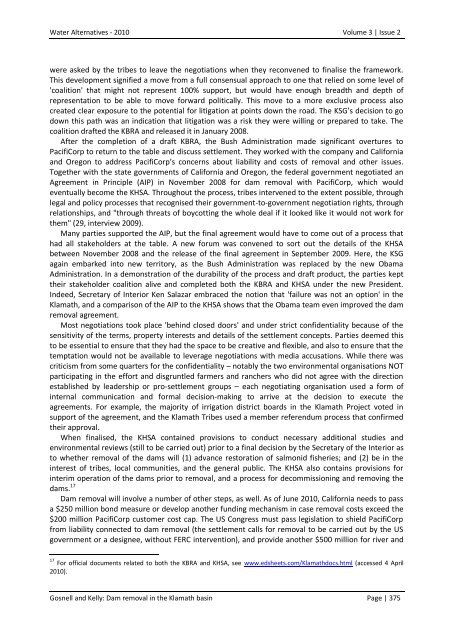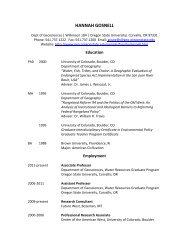Peace on the River? Social-Ecological ... - Water Alternatives
Peace on the River? Social-Ecological ... - Water Alternatives
Peace on the River? Social-Ecological ... - Water Alternatives
You also want an ePaper? Increase the reach of your titles
YUMPU automatically turns print PDFs into web optimized ePapers that Google loves.
<strong>Water</strong> <strong>Alternatives</strong> - 2010 Volume 3 | Issue 2<br />
were asked by <strong>the</strong> tribes to leave <strong>the</strong> negotiati<strong>on</strong>s when <strong>the</strong>y rec<strong>on</strong>vened to finalise <strong>the</strong> framework.<br />
This development signified a move from a full c<strong>on</strong>sensual approach to <strong>on</strong>e that relied <strong>on</strong> some level of<br />
'coaliti<strong>on</strong>' that might not represent 100% support, but would have enough breadth and depth of<br />
representati<strong>on</strong> to be able to move forward politically. This move to a more exclusive process also<br />
created clear exposure to <strong>the</strong> potential for litigati<strong>on</strong> at points down <strong>the</strong> road. The KSG’s decisi<strong>on</strong> to go<br />
down this path was an indicati<strong>on</strong> that litigati<strong>on</strong> was a risk <strong>the</strong>y were willing or prepared to take. The<br />
coaliti<strong>on</strong> drafted <strong>the</strong> KBRA and released it in January 2008.<br />
After <strong>the</strong> completi<strong>on</strong> of a draft KBRA, <strong>the</strong> Bush Administrati<strong>on</strong> made significant overtures to<br />
PacifiCorp to return to <strong>the</strong> table and discuss settlement. They worked with <strong>the</strong> company and California<br />
and Oreg<strong>on</strong> to address PacifiCorp’s c<strong>on</strong>cerns about liability and costs of removal and o<strong>the</strong>r issues.<br />
Toge<strong>the</strong>r with <strong>the</strong> state governments of California and Oreg<strong>on</strong>, <strong>the</strong> federal government negotiated an<br />
Agreement in Principle (AIP) in November 2008 for dam removal with PacifiCorp, which would<br />
eventually become <strong>the</strong> KHSA. Throughout <strong>the</strong> process, tribes intervened to <strong>the</strong> extent possible, through<br />
legal and policy processes that recognised <strong>the</strong>ir government-to-government negotiati<strong>on</strong> rights, through<br />
relati<strong>on</strong>ships, and "through threats of boycotting <strong>the</strong> whole deal if it looked like it would not work for<br />
<strong>the</strong>m" (29, interview 2009).<br />
Many parties supported <strong>the</strong> AIP, but <strong>the</strong> final agreement would have to come out of a process that<br />
had all stakeholders at <strong>the</strong> table. A new forum was c<strong>on</strong>vened to sort out <strong>the</strong> details of <strong>the</strong> KHSA<br />
between November 2008 and <strong>the</strong> release of <strong>the</strong> final agreement in September 2009. Here, <strong>the</strong> KSG<br />
again embarked into new territory, as <strong>the</strong> Bush Administrati<strong>on</strong> was replaced by <strong>the</strong> new Obama<br />
Administrati<strong>on</strong>. In a dem<strong>on</strong>strati<strong>on</strong> of <strong>the</strong> durability of <strong>the</strong> process and draft product, <strong>the</strong> parties kept<br />
<strong>the</strong>ir stakeholder coaliti<strong>on</strong> alive and completed both <strong>the</strong> KBRA and KHSA under <strong>the</strong> new President.<br />
Indeed, Secretary of Interior Ken Salazar embraced <strong>the</strong> noti<strong>on</strong> that 'failure was not an opti<strong>on</strong>' in <strong>the</strong><br />
Klamath, and a comparis<strong>on</strong> of <strong>the</strong> AIP to <strong>the</strong> KHSA shows that <strong>the</strong> Obama team even improved <strong>the</strong> dam<br />
removal agreement.<br />
Most negotiati<strong>on</strong>s took place 'behind closed doors' and under strict c<strong>on</strong>fidentiality because of <strong>the</strong><br />
sensitivity of <strong>the</strong> terms, property interests and details of <strong>the</strong> settlement c<strong>on</strong>cepts. Parties deemed this<br />
to be essential to ensure that <strong>the</strong>y had <strong>the</strong> space to be creative and flexible, and also to ensure that <strong>the</strong><br />
temptati<strong>on</strong> would not be available to leverage negotiati<strong>on</strong>s with media accusati<strong>on</strong>s. While <strong>the</strong>re was<br />
criticism from some quarters for <strong>the</strong> c<strong>on</strong>fidentiality – notably <strong>the</strong> two envir<strong>on</strong>mental organisati<strong>on</strong>s NOT<br />
participating in <strong>the</strong> effort and disgruntled farmers and ranchers who did not agree with <strong>the</strong> directi<strong>on</strong><br />
established by leadership or pro-settlement groups – each negotiating organisati<strong>on</strong> used a form of<br />
internal communicati<strong>on</strong> and formal decisi<strong>on</strong>-making to arrive at <strong>the</strong> decisi<strong>on</strong> to execute <strong>the</strong><br />
agreements. For example, <strong>the</strong> majority of irrigati<strong>on</strong> district boards in <strong>the</strong> Klamath Project voted in<br />
support of <strong>the</strong> agreement, and <strong>the</strong> Klamath Tribes used a member referendum process that c<strong>on</strong>firmed<br />
<strong>the</strong>ir approval.<br />
When finalised, <strong>the</strong> KHSA c<strong>on</strong>tained provisi<strong>on</strong>s to c<strong>on</strong>duct necessary additi<strong>on</strong>al studies and<br />
envir<strong>on</strong>mental reviews (still to be carried out) prior to a final decisi<strong>on</strong> by <strong>the</strong> Secretary of <strong>the</strong> Interior as<br />
to whe<strong>the</strong>r removal of <strong>the</strong> dams will (1) advance restorati<strong>on</strong> of salm<strong>on</strong>id fisheries; and (2) be in <strong>the</strong><br />
interest of tribes, local communities, and <strong>the</strong> general public. The KHSA also c<strong>on</strong>tains provisi<strong>on</strong>s for<br />
interim operati<strong>on</strong> of <strong>the</strong> dams prior to removal, and a process for decommissi<strong>on</strong>ing and removing <strong>the</strong><br />
dams. 17<br />
Dam removal will involve a number of o<strong>the</strong>r steps, as well. As of June 2010, California needs to pass<br />
a $250 milli<strong>on</strong> b<strong>on</strong>d measure or develop ano<strong>the</strong>r funding mechanism in case removal costs exceed <strong>the</strong><br />
$200 milli<strong>on</strong> PacifiCorp customer cost cap. The US C<strong>on</strong>gress must pass legislati<strong>on</strong> to shield PacifiCorp<br />
from liability c<strong>on</strong>nected to dam removal (<strong>the</strong> settlement calls for removal to be carried out by <strong>the</strong> US<br />
government or a designee, without FERC interventi<strong>on</strong>), and provide ano<strong>the</strong>r $500 milli<strong>on</strong> for river and<br />
17 For official documents related to both <strong>the</strong> KBRA and KHSA, see www.edsheets.com/Klamathdocs.html (accessed 4 April<br />
2010).<br />
Gosnell and Kelly: Dam removal in <strong>the</strong> Klamath basin Page | 375






